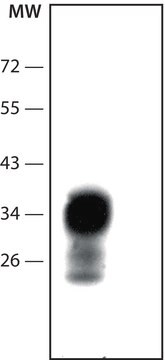SAB4200120
Anti-Ephrin-B2 antibody ,Mouse monoclonal
clone EFR-163M, purified from hybridoma cell culture
同義詞:
Anti-EFNB2, Anti-EPH-related receptor tyrosine kinase ligand 5, Anti-EPLG5 ligand of EPH-related kinase 5, Anti-HTK ligand, Anti-HTKL, Anti-LERK5
登入查看組織和合約定價
全部照片(3)
About This Item
分類程式碼代碼:
51111800
NACRES:
NA.41
推薦產品
生物源
mouse
共軛
unconjugated
抗體表格
purified from hybridoma cell culture
抗體產品種類
primary antibodies
無性繁殖
EFR-163M, monoclonal
形狀
buffered aqueous solution
分子量
antigen ~56 kDa
物種活性
human
濃度
~1.0 mg/mL
技術
western blot: 0.5-1.0 μg/mL using whole extracts of HEK-293T cells overexpressing a human Ephrin-B2 fusion protein
同型
IgG1
UniProt登錄號
運輸包裝
dry ice
儲存溫度
−20°C
目標翻譯後修改
unmodified
基因資訊
human ... EFNB2(1948)
一般說明
Eph family of tyrosine kinase receptors mediates cell-cell attachment and aggregation by binding to specific ligands, ephrins. The Eph family consists of 14 structurally related receptors that are either membrane linked or are transmembrane with overlapping affinity for ligands. The transmembrane receptor Ephrin-B2 signals through its cognate receptor EphB4. The signalling via EphB4 receptor ensures is crucial in the initial stages of vasculogenesis in marking specific arterial and venous domains. Ephrin-B2 is also essential in the development stages for neural crest formation, angiogenesis, vascular cell assembly, migration and synapse development in central nervous system
Anti-Ephrin-B2 recognizes human Ephrin-B2 protein (~56 kDa).
Anti-Ephrin-B2 recognizes human Ephrin-B2 protein (~56 kDa).
Ephrin-B2 is a member of the ephrin-B (EPH) family. The ephrins and EPH-related receptors comprise the largest subfamily of receptor protein-tyrosine kinases. Ephrins are divided into ephrin-A (EFNA) class, which are anchored to the membrane by a glycosylphosphatidylinositol linkage and the ephrin-B (EFNB) class, which are transmembrane proteins. Ephrin-B2 binds the tyrosine kinase receptors EphB4 and EphA3 and is expressed by arteries whereas its receptor tyrosine kinase EphB4 is expressed by veins.
免疫原
human Ephrin-B2 recombinant protein. The human protein shares 97% homology with the mouse protein.
應用
Anti-Ephrin-B2 antibody may be used for immunoblotting at a working concentration of 0.5-1.0 μg/ml using whole cell lysates of HEK-293T cells over-expressing human Ephrin-B2. It is also suitable for immunohistochemistry of formalin-fixed, paraffin-embedded human skin sections.
生化/生理作用
Ephrin-B2 and EphB4 are essential for proper development of the cardiovascular system. It is implicated in regulating erythropoiesis. Mutations in these genes are linked to embryonic lethality, defects in the angiogenic remodeling of the peripheral vasculature and defective myocardial trabeculation in the heart.
外觀
0.01M 磷酸缓冲盐溶液,pH 7.4,含 15mM 叠氮化钠。
免責聲明
Unless otherwise stated in our catalog or other company documentation accompanying the product(s), our products are intended for research use only and are not to be used for any other purpose, which includes but is not limited to, unauthorized commercial uses, in vitro diagnostic uses, ex vivo or in vivo therapeutic uses or any type of consumption or application to humans or animals.
未找到適合的產品?
試用我們的產品選擇工具.
儲存類別代碼
10 - Combustible liquids
閃點(°F)
Not applicable
閃點(°C)
Not applicable
分析證明 (COA)
輸入產品批次/批號來搜索 分析證明 (COA)。在產品’s標籤上找到批次和批號,寫有 ‘Lot’或‘Batch’.。
Functions of ephrin/Eph interactions in the development of the nervous system: emphasis on the hippocampal system
Martinez A and Soriano E
Brain Research Reviews, 49(2), 211-226 (2005)
Regulation of angiogenesis by Eph-ephrin interactions
Kuijper S, et al.
Trends in Cardiovascular Medicine, 17(5), 145-151 (2007)
Ephrin-B2 is a candidate ligand for the Eph receptor, EphB6
Munthe E, et al.
Febs Letters, 466(1), 169-174 (2000)
Regulation of vasculogenesis and angiogenesis by EphB/ephrin-B2 signaling between endothelial cells and surrounding mesenchymal cells
Oike Y, et al.
Blood, 100(4), 1326-1333 (2002)
A role of EphB4 receptor and its ligand, ephrin-B2, in erythropoiesis
Suenobu S, et al.
Biochemical and Biophysical Research Communications, 293(3), 1124-1131 (2002)
我們的科學家團隊在所有研究領域都有豐富的經驗,包括生命科學、材料科學、化學合成、色譜、分析等.
聯絡技術服務